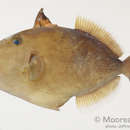Diagnostic Description
provided by Fishbase
Juveniles sand-colored with numerous thin black pinstripes (Ref. 1602); adult males with an oblique yellow band from the corner of mouth backward and another under the chin (Ref. 4420).Description: Characterized further by having longitudinal scale rows 43-54; presence of deep groove in front of eye; nearly straight dorsal and ventral head profiles; body with series of longitudinal ridges bearing small spiny tubercles, ridges extending forward to front of second dorsal fin; rounded caudal fin in juvenile, truncate to slightly double emarginate in adult (Ref. 90102).
- Recorder
- Cristina V. Garilao
Life Cycle
provided by Fishbase
Distinct pairing (Ref. 205). Females are territorial, solely tending and guarding the eggs (Ref. 116451). Males exhibit polygyny (Ref. 116451).
Migration
provided by Fishbase
Oceanodromous. Migrating within oceans typically between spawning and different feeding areas, as tunas do. Migrations should be cyclical and predictable and cover more than 100 km.
Morphology
provided by Fishbase
Dorsal spines (total): 3; Dorsal soft rays (total): 27 - 31; Analspines: 0; Analsoft rays: 24 - 28
- Recorder
- Cristina V. Garilao
Biology
provided by Fishbase
Inhabit coastal rocky reefs, often silty habitats and in lagoons on open sand (Ref. 48637). Solitary (Ref. 90102). Found over sand and rubble patches of seaward reefs (Ref. 205). Benthopelagic (Ref. 58302). Feed on echinoids, fishes, mollusks, tunicates, crustaceans, algae, polychaete worms, foraminiferans and detritus. Oviparous (Ref. 205).
Importance
provided by Fishbase
fisheries: minor commercial; aquarium: commercial; price category: medium; price reliability: very questionable: based on ex-vessel price for species in this family
分布
provided by The Fish Database of Taiwan
分布於印度-太平洋區,西起非洲東岸,東至土木土及馬貴斯群島,北至日本南部,南至羅得豪島。台灣分布於北部、南部、東部、東北部及綠島等海域。
利用
provided by The Fish Database of Taiwan
通常以陷阱法、潛水或流刺網捕獲,以生鮮或醃製於市場出售,或以其可愛的模樣而常被飼養於水族館中,供人欣賞。
描述
provided by The Fish Database of Taiwan
體稍延長,呈長橢圓形,
尾柄短。口端位,齒白具缺刻。眼前有一深溝。頰部被鱗;鰓裂後有大型骨質鱗片。尾柄鱗片具小棘列,且向前延伸至身體中央,第一背鰭下方。背鰭兩個,基底相接近,第一背鰭位於鰓孔上方,第I棘粗大,第II棘則細長,第III背鰭棘明顯;背鰭及臀鰭軟條截平;尾鰭弧形。體深褐色;雄魚在口角有一白帶向後延伸至胸鰭基前方,雌魚無此色帶;除胸鰭褐色外,餘鰭皆為深褐色。
棲地
provided by The Fish Database of Taiwan
主要棲息於砂岩混合之向海礁區。主要以甲殼類、軟體動物、蠕蟲、被囊動物、卵及碎屑等為食。
Masked triggerfish
provided by wikipedia EN
- license
- cc-by-sa-3.0
- copyright
- Wikipedia authors and editors
Masked triggerfish: Brief Summary
provided by wikipedia EN
The masked triggerfish (Sufflamen fraenatum) is a species of triggerfish usually found living in coastal reefs or in lagoons. The range of depths where these triggerfish can live varies from 8 to 186 m.
They are found along the Indian Ocean coast of Africa and throughout much of the Indo-Pacific region from Indonesia to the Hawaiian Islands.
- license
- cc-by-sa-3.0
- copyright
- Wikipedia authors and editors
Habitat
provided by World Register of Marine Species
Known from seamounts and knolls
Stocks, K. 2009. Seamounts Online: an online information system for seamount biology. Version 2009-1. World Wide Web electronic publication.
- license
- cc-by-4.0
- copyright
- WoRMS Editorial Board

